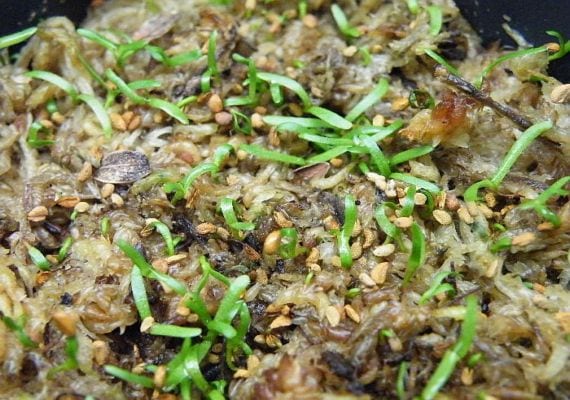
The seeds of carnivorous plants are characterized above all by being very small. Those of the Droseras genus, for example, are not much larger than the point of a pin. You have to be very careful to prevent the air from taking them away. It is curious that from such a tiny seed, a plant as interesting as a carnivorous plant.
They are really easy to reproduce, both by seed and by suckers. There are only a couple of things to keep in mind.
There are three types of carnivorous plant reproduction: by seeds, cuttings or by division of the plant. Up next, each of the preview are described:

Reproduction by seeds
The first and most important thing is to acquire fresh seeds, as this will guarantee a high percentage of germination.
The substrate that experts recommend is -only- sphagnum, either dehydrated or live. If it is not found in nurseries, we will find it in online carnivore stores. It is usually well priced, more if you only want to make a couple of seedlings. Positive results can also be obtained by using peat moss alone, or with pearlite. It is highly advisable to add a little - very little, less than a pinch - of sulfur on the surface of the pot to avoid fungi.
Location: if we place the seedbeds outside, direct sun should be avoided. Ideally, it would be a semi-shady place.
We must irrigate with distilled or rain water. High humidity is important for a good germination rate of carnivorous plants.
Depending on the species, it can take from a few days (Droseras, Dioneas, Sarracenias) to a few weeks to germinate. I advise using a magnifying glass to distinguish the newly germinated seeds. Sometimes you only see a Green Point, and it can be confused with sphagnum, especially if we have used live sphagnum.
The temperature should be around twenty-five or thirty degrees, in most species. There are some like those of the genre Drosophyllum or the Nordic sundew, whose seeds need to be cold for one or two months before germinating. In these cases, they will be placed in a tupperware on wet sphagnum, with some sulfur on the surface, in the refrigerator (in the vegetable section), at about five or six degrees. They should be controlled from time to time, to avoid fungi.
Reproduction by cuttings
There are very few genera of carnivorous plants that allow this type of reproduction. One of them is the Nepenthes (better known as Pitcher Plants). The cuttings are from stems. The stem that have no traps formed, with two or three leaves. Rooting hormones will be put on it (not many, only a very thin layer), and it will be placed in a pot with sphagnum which we will have previously watered, in a warm place with semi-shade.
Reproduction by division and / or suckers
It is, perhaps, the easiest and fastest method. All you have to do is remove the plant from the pot, remove all the substrate, and with scissors cut the carnivorous plants that interest us, or carefully separate the suckers from the mother plant.
Whether it is a division or if the suckers have been removed, they will be placed in a pot with blond peat or sphagnum, previously watered, in semi-shade. The genera of the Droseras and Sarracenias to grow so fast, and so vigorously allow this type of reproduction.
More information - Caring for carnivorous plants
Image - dionae, Stephen Studd